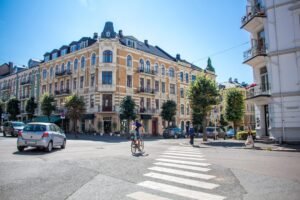

Norwegian Vocabulary for Hikers: Norwegian Terms for Your Outdoor Adventures
When embarking on a hiking adventure in Norway, it is important to have a basic understanding of the Norwegian language. While many Norwegians speak English, especially in tourist areas, knowing some Norwegian vocabulary can greatly enhance your hiking experience. It allows you to communicate with locals, read signs and markers, and navigate the trails more effectively. In this article, we will explore the essential Norwegian vocabulary for hikers, from basic phrases to advanced technical terms.
Table of Contents
ToggleKey Takeaways
- Norwegian vocabulary is important for hikers in Norway to communicate effectively and navigate trails.
- Basic Norwegian phrases such as “hello” and “thank you” are essential for polite interactions with locals.
- Essential Norwegian words for trail navigation include “stien” (trail) and “kart” (map).
- Norwegian terms for different types of terrain include “fjell” (mountain) and “skog” (forest).
- Norwegian vocabulary for weather and climate includes “regn” (rain) and “sol” (sun).
Basic Norwegian Phrases for Hikers
To start off, let’s learn some common greetings and pleasantries that will come in handy when interacting with locals. “Hei” is the Norwegian word for “hello” and can be used in any situation. “Takk” means “thank you” and “ha det bra” means “goodbye”. These simple phrases will help you establish a friendly connection with the locals and show your appreciation for their assistance.
When hiking in Norway, it is inevitable that you may need to ask for directions or help at some point. Learning phrases such as “Unnskyld meg, hvor er…?” (Excuse me, where is…?) and “Kan du hjelpe meg?” (Can you help me?) will make it easier for you to communicate your needs to others. Additionally, knowing how to order food and drinks in Norwegian will be useful during your hiking trips. Phrases like “Jeg vil gjerne ha…” (I would like…) and “En kopp kaffe, takk” (A cup of coffee, please) will ensure that you can refuel and recharge along the way.
Essential Norwegian Words for Trail Navigation
When hiking in Norway, it is important to be familiar with the names of different types of trails. The word “sti” means trail or path, while “fjell” refers to mountains. “Dal” is the Norwegian word for valley, and “fjord” is a narrow inlet of the sea between high cliffs or mountains. These terms will help you understand the terrain and plan your hiking routes accordingly.
In addition to trail names, knowing directions and orientation terms is crucial for successful navigation. “Nord” means north, “sør” means south, “øst” means east, and “vest” means west. These cardinal directions will guide you along your hiking journey. Furthermore, being able to recognize signs and markers is essential for staying on the right path. Words like “start” (start), “mål” (goal), and “veikryss” (junction) will help you interpret the signs and make informed decisions.
Norwegian Terms for Different Types of Terrain
Norway is known for its stunning landscapes, including mountains, valleys, fjords, and glaciers. To fully appreciate the beauty of these natural wonders, it is helpful to know the Norwegian vocabulary associated with them. “Fjell” refers to mountains, while “topp” means peak. “Dal” is the word for valley, and “fjord” represents the iconic narrow inlets of the sea surrounded by towering cliffs or mountains. Lastly, “bre” is the Norwegian term for glacier or ice field.
By understanding these terms, you can better describe the terrain you encounter during your hikes and appreciate the unique features of Norway’s landscapes. Whether you are climbing a mountain peak or exploring a deep valley, having the right vocabulary will enrich your hiking experience.
Norwegian Vocabulary for Weather and Climate
Weather conditions can greatly impact your hiking experience, so it is important to be prepared and knowledgeable about different types of weather in Norway. Learning words such as “sol” (sun), “regn” (rain), “snø” (snow), and “tåke” (fog) will help you understand the current weather conditions and plan your hikes accordingly.
In addition to weather conditions, knowing temperature and wind speed terms is essential for dressing appropriately and staying safe. “Grader” means degrees, “varm” means warm, “kald” means cold, “vind” means wind, and “styrke” means strength. By understanding these terms, you can gauge the temperature and wind conditions and adjust your clothing and gear accordingly.
Lastly, being familiar with precipitation and humidity terms will help you anticipate the level of moisture in the air. “Nedbør” means precipitation, “regn” means rain, “snø” means snow, and “fuktighet” means humidity. These terms will allow you to plan for wet or dry conditions and make informed decisions about your hiking routes.
Norwegian Words for Hiking Gear and Equipment
Having the right gear and equipment is essential for a successful hiking trip. Learning the Norwegian vocabulary for hiking gear will help you communicate your needs when shopping for equipment or seeking assistance from locals.
When it comes to clothing and footwear, words like “jakke” (jacket), “bukse” (pants), “støvler” (boots), and “lue” (hat) will come in handy. Additionally, knowing the Norwegian words for backpacks (“ryggsekk”) and tents (“telt”) will allow you to communicate your needs when purchasing or renting camping gear.
Furthermore, being familiar with navigation tools such as maps (“kart”), compasses (“kompass”), and GPS devices (“GPS-enhet”) will help you navigate the trails more effectively. Lastly, knowing first aid kit (“førstehjelpsutstyr”) vocabulary will ensure that you can communicate your medical needs in case of an emergency.
Norwegian Vocabulary for Wildlife and Nature
Norway is home to a diverse range of wildlife and natural wonders. Learning the Norwegian vocabulary for animals, birds, trees, plants, and geology will enhance your appreciation of the country’s natural beauty.
When it comes to animals and birds, words like “elg” (moose), “rev” (fox), “ørn” (eagle), and “ravn” (raven) will help you identify and describe the wildlife you encounter during your hikes. Additionally, knowing the names of trees and plants such as “bjørk” (birch), “gran” (spruce), “blåbær” (blueberry), and “fjellflokk” (mountain avens) will allow you to appreciate the flora of Norway.
Lastly, understanding geology and rock formation terms such as “stein” (rock), “fjell” (mountain), “klippe” (cliff), and “foss” (waterfall) will help you describe the unique geological features you come across during your hikes.
Norwegian Terms for Camping and Outdoor Cooking
Camping is a popular activity among hikers in Norway, and knowing the Norwegian vocabulary for camping and outdoor cooking is essential for a successful camping experience.
To start off, learning how to set up camp is crucial. Words like “telt” (tent), “sovepose” (sleeping bag), “liggeunderlag” (sleeping pad), and “hengekøye” (hammock) will help you communicate your camping needs. Additionally, knowing how to build a fire is important for warmth and cooking. Words like “ved” (firewood), “tenne” (ignite), and “bål” (campfire) will come in handy when setting up a fire.
Furthermore, being able to cook and prepare food outdoors is an essential skill for camping. Words like “matlaging” (cooking), “kokeapparat” (stove), “gryte” (pot), and “bestikk” (utensils) will help you communicate your cooking needs and preferences.
Common Norwegian Phrases for Interacting with Locals
Interacting with locals can greatly enhance your hiking experience in Norway. Learning common phrases for asking for recommendations and advice will help you discover hidden gems and local favorites. Phrases like “Kan du anbefale en fin tur?” (Can you recommend a nice hike?) and “Hva er det beste stedet å se solnedgangen?” (What is the best place to watch the sunset?) will help you engage with locals and gather valuable information.
Additionally, knowing how to order food and drinks in local restaurants will allow you to experience the local cuisine. Phrases like “Jeg vil gjerne ha…” (I would like…) and “Hva er spesialiteten her?” (What is the specialty here?) will help you navigate the menu and make informed choices.
Lastly, making small talk with locals is a great way to connect and learn more about the culture. Phrases like “Hvordan har du det?” (How are you?) and “Hva er din favorittting å gjøre i dette området?” (What is your favorite thing to do in this area?) will help you initiate conversations and create meaningful connections.
Advanced Norwegian Vocabulary for Experienced Hikers
For experienced hikers looking to take their skills to the next level, learning advanced Norwegian vocabulary is essential. Technical terms for mountaineering and rock climbing, such as “klatring” (climbing), “tau” (rope), “karabiner” (carabiner), and “klatresko” (climbing shoes) will come in handy when engaging in more challenging activities.
Additionally, advanced navigation and orientation terms such as “kartlesing” (map reading), “koordinater” (coordinates), “høydemeter” (altitude), and “kompasskurs” (compass bearing) will help you navigate more complex terrains and plan your routes effectively.
Lastly, specialized gear and equipment vocabulary such as “isøks” (ice axe), “klatresele” (climbing harness), “klatrehjelm” (climbing helmet), and “klatretau” (climbing rope) will be useful for advanced hikers engaging in mountaineering or rock climbing activities.
Learning Norwegian vocabulary for hikers is essential for a successful hiking experience in Norway. From basic phrases to advanced technical terms, having a good understanding of the language will enhance your communication with locals, allow you to navigate the trails more effectively, and deepen your appreciation of Norway’s natural beauty. So, whether you are a beginner hiker or an experienced mountaineer, take the time to learn and practice Norwegian for a better hiking experience in Norway.
If you want to learn Norwegian, you can register for classes here. We look forward to hearing from you and helping you become fluent in Norwegian.





